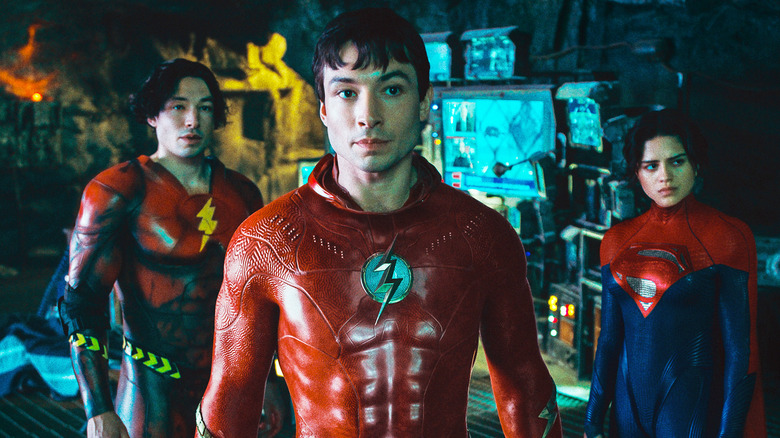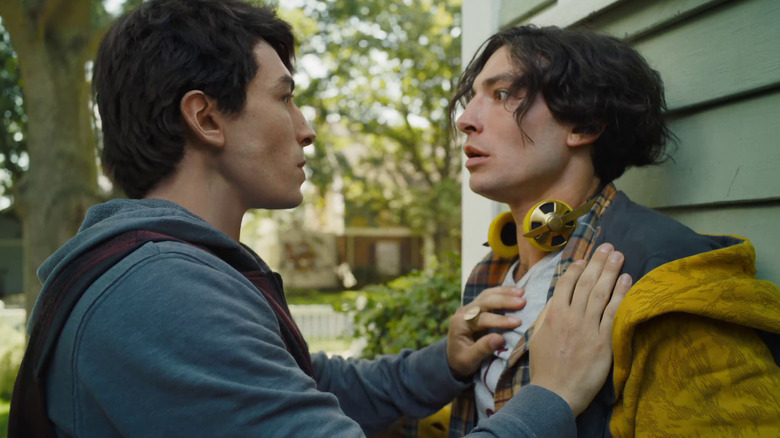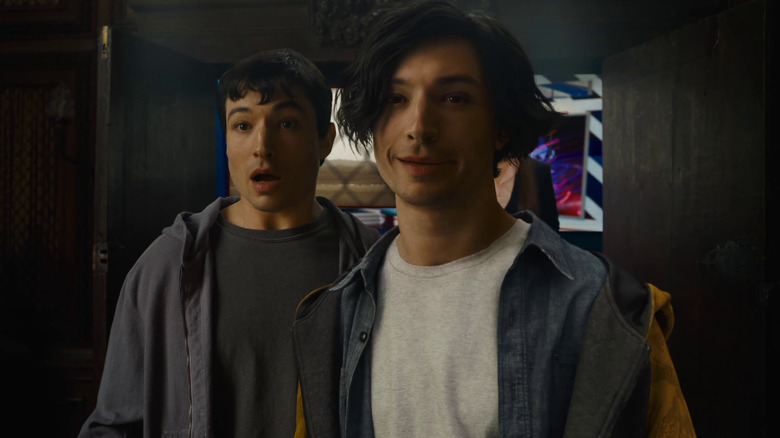The Flash Used An Unexpected Filmmaking Technique To Clone Ezra Miller
This post contains spoilers for "The Flash"
The Flash has finally gotten his first solo movie. And it was okay. I had high hopes for "The Flash," even though I was worried about Michael Keaton's return (rightly, it turns out). With a storyline that involved Ezra Miller's Barry Allen traveling back in time to prevent his mother's murder, the film had the potential for some genuinely moving moments and meaningful emotional stakes. Keaton was back, and Stephen King and Tom Cruise seemed to like it. What could go wrong?
Well, rather than get into everything that did go wrong (apparently that god-awful CGI was "on purpose") I'll just say that "The Flash" is not without its charms — one of which is the double Barry Allen element. When Barry uses the speed force to travel back in time and tweak events, he finds himself in an alternate universe, complete with an alternate version of himself. Both are played by Ezra Miller, who I think it's fair to say, does a decent job not only of making the two characters feel like two distinct people, but also acting alongside themselves.
Director Andy Muschietti clearly isn't the first filmmaker to use the same actor for two separate characters and have them interact on-screen. In fact, this kind of thing is barely a visual effect any more. If "Friends" could convince you there were two Lisa Kudrows acting alongside one another back in the '90s, then it's not really all that impressive an effect in 2023. However, Miller basically carries this movie, with extensive scenes showcasing the evolution of Barry's bond with his alternate version. That required something a little more complicated than splitting a shot down the middle and using two separate takes stitched together. In fact, it required a first in visual effects.
Enter 'The Volume'
While there's a lot to be bewildered by in terms of VFX in "The Flash," the scenes with two Barry Allens are pretty flawless. In a movie that managed to desecrate the memory of Christopher Reeve with a CGI double that looks about as convincing as a cardboard cutout that's been left out in the rain, the double Barry scenes are a relative triumph. Ezra Miller interacts with their on-screen double in such an impressively effortless way that it really makes you wonder how they pulled it all off.
Well, wonder no more, because Andy Muschietti has revealed all on the latest episode of IndieWire's Toolkit podcast. Turns out, they used an entirely new method for filming these scenes called "Volume Capture," which involved capturing a "photorealistic scan of a performance" after shooting the entire film, then editing that performance back into the movie. Muschietti explained how he shot each scene involving the two Barrys with Miller and another actor, who would perform opposite Miller with a camera on their head. Why? Because once all the scenes were shot, Muschietti could use the footage from this camera in something called "the Volume." As the filmmaker put it:
"When the movie is finally edited and you know every single beat of the scene with the takes and everything, you bring Ezra back to this thing called the Volume, which is basically a room with a hundred cameras. The result of that is that you end up with a digital asset of a performance that is photorealistic, because it was captured by a hundred cameras. And [they] are interacting with a projection on the walls where these cameras are, [and] it comes from a camera that was on top of the head of the second actor the day of the shoot."
Half of Miller's performance was shot after the film was done
Once Andy Muschietti captured this "photorealistic" performance, he could add it back into the completed scenes, replacing the actor who doubled for Ezra Miller on the actual shoot day. Which essentially means that half of Miller's performance was actually filmed in post-production. Muschietti added:
"It's the first time that it was done. I'm kind of proud of it, but it was a bit of a leap of faith in that sense, because it was never proved before, so there was a lot of development to refine the process and the final product."
Interestingly enough, the director and Miller decided which version of Barry the actor would play based on which version had the most lines in a given scene, prompting Muschietti to remark, "Ezra was constantly — even on the same day, [they] were playing different characters." It would have been impressive enough for Miller to have alternated between the two characters had he shot them entirely separately, but to bounce back and forth between the two Barrys depending on which scene he was shooting is pretty remarkable.
Unfortunately, that's about the most remarkable thing in "The Flash," aside from the fact they put out a movie that had been in production for almost a decade with CGI that looks like a half-rendered PS2 cutscene. Maybe it really is time for superhero movies to take a nice long break.


